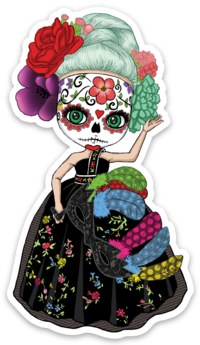La Catrina is a female representation of death in Mexican art. But who is she exactly? Is she based on an actual person? Keep reading to learn more.
Who Is La Catrina?
La Catrina, or “the well-dressed one,” is a depiction of death wearing elegant clothes that is common in Mexican art.
As for the identity of La Catrina, she’s not based on an actual person. She is rather a symbol meant to represent death and the way Mexicans relate to it.
The history of La Catrina dates back to the Aztecs, who worshiped many deities associated with death, including Mictecacihuatl, queen of the underworld.
However, the most iconic depiction of a skeleton wearing elegant female accessories was created by Mexican painter and engraver José Guadalupe Posada in 1912.
From the “Calavera Garbancera” to Diego Rivera’s Catrina
Posada’s drawing is known as “calavera garbancera.” “Garbancero” was a term used in early 20th-century Mexico to refer to people who denied their indigenous heritage to embrace European customs, including fashion. The image is accompanied by a long poem where the author admonishes women who pay excessive attention to their image.
Curiously enough, this first version of La Catrina showed her only from the neck up. The elegance came from her ornate hat that evoked the class and refinement of Parisian fashion (the Mexican wealthy of the 1910s starting with President Porfirio Díaz looked up to French culture as the ultimate example of civilization).
The next step in the evolution of La Catrina came thanks to Diego Rivera, one of Mexico’s most famous painters.

The central character of Rivera’s 1947 mural “Sueño de una Tarde Dominical en la Alameda Central” (Dream of a Sunday Afternoon at Alameda Central Park) is a skeleton attired in elegant female clothes, including a hat that strongly resembles that of Posada’s “calavera garbancera.”
The mural brings together some of the most emblematic characters of different periods of Mexico’s history, including Posada (the creator of the “calavera garbancera”), Frida Kahlo (Rivera’s wife), Hernan Cortes, Benito Juarez, Porfirio Diaz, and many more.
The mural aims to depict the entire history of Mexico after the Spanish conquest in one sweeping, highly detailed image.
The fact that Rivera gave his version of la “calavera garbancera” the central spot in the group speaks volumes about the importance of death in Mexican culture and explains why La Catrina has achieved such iconic status in Mexico and beyond.
Sabukana: Unapologetically Embrace Yourself
Sabukana was created by two Latina sisters, Melanie and Scarlett, to celebrate their Latin roots and multicultural upbringing with a modern twist.
Our creations are made for people who unapologetically embrace their own. They represent our cultures, serving as a reminder of where we come from and who we are.















